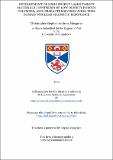Files in this item
Development of high energy laser target materials : synthesis of low density porous polymers, and characterisation using time domain nuclear magnetic resonace
Item metadata
| dc.contributor.advisor | Nazarov, Wigen | |
| dc.contributor.author | Musgrave, Christopher S. A. | |
| dc.coverage.spatial | xii, 219 p. | en_US |
| dc.date.accessioned | 2015-07-29T15:16:33Z | |
| dc.date.available | 2015-07-29T15:16:33Z | |
| dc.date.issued | 2014-12 | |
| dc.identifier.uri | https://hdl.handle.net/10023/7074 | |
| dc.description.abstract | This work details the synthesis of low density porous polymers, and characterisation with an emphasis on Time Domain Nuclear Magnetic Resonance (TD-NMR). High energy laser physics utilises low density porous polymers to study astrophysical phenomena at high pressures and temperatures in the form of plasma. Low Z, low density Polymerised High Internal Phase Emulsions (PolyHIPE) and aerogels form a large part of these capabilities, however increasingly stringent laser target parameters are now required to develop new capabilities. For low density porous polymers, this demands greater control over properties such as pore size, density, composition (C[sub]nH[sub](>n)) and homogeneity through novel synthesis and characterisation. Microstructure inhomogeneity of styrene-co-divinyl benzene (S-co-DVB) polyHIPEs in conjunction with novel t-butyl styrene and para divinyl benzene polyHIPEs were investigated using ¹H spin-lattice (T₁) and spin-lock (T[sub](1ρ)) NMR relaxation experiments using TD-NMR. The strong relationship between ¹H spin-lattice relaxation times and Dynamic Mechanical Analysis (DMA) data, and application of relaxation experiments at varied temperatures reveal that structural inhomogeneity is based on poor emulsion stability and clustering of DVB polymer affecting bulk molecular motion. Divinyl benzene (DVB) aerogels and a range of innovative C[sub]nH[sub](>n) aerogels such as poly-5-vinyl-2-norbornene were synthesised using free-radical, cationic or ring opening metathesis polymerisation techniques. A one-step synthesis of homogeneous density gradient DVB aerogels was developed for the first time, which is fundamental to be able to study plasma shock fronts. Characterisation using X-ray tomography revealed the homogeneous density gradient. Successful carbonisation of dichloroparaxylene (DCPX) aerogels has similar properties to resorcinol-formaldehyde (RF) aerogels, but is produced in significantly less time and shrinkage, presents as a candidate for future laser experiments. Correlation between NMR relaxation times to established techniques of DMA and mercury porosimetry was explored to determine the suitability of TD-NMR in characterisation of low density porous polymers. | en_US |
| dc.language.iso | en | en_US |
| dc.publisher | University of St Andrews | |
| dc.rights | Creative Commons Attribution-NonCommercial-NoDerivatives 4.0 International | |
| dc.rights.uri | http://creativecommons.org/licenses/by-nc-nd/4.0/ | |
| dc.subject | PolyHIPE | en_US |
| dc.subject | TD-NMR | en_US |
| dc.subject.lcc | QD381.8M8 | |
| dc.subject.lcsh | Polymers--Synthesis | en_US |
| dc.subject.lcsh | Polymers--Analysis | en_US |
| dc.subject.lcsh | Foamed materials | en_US |
| dc.subject.lcsh | Aerogels | en_US |
| dc.subject.lcsh | High power lasers | en_US |
| dc.subject.lcsh | Laser plasmas | en_US |
| dc.subject.lcsh | Nuclear magnetic resonance | en_US |
| dc.title | Development of high energy laser target materials : synthesis of low density porous polymers, and characterisation using time domain nuclear magnetic resonace | en_US |
| dc.type | Thesis | en_US |
| dc.contributor.sponsor | Atomic Weapons Establishment (Great Britain) | en_US |
| dc.type.qualificationlevel | Doctoral | en_US |
| dc.type.qualificationname | PhD Doctor of Philosophy | en_US |
| dc.publisher.institution | The University of St Andrews | en_US |
This item appears in the following Collection(s)
Except where otherwise noted within the work, this item's licence for re-use is described as Creative Commons Attribution-NonCommercial-NoDerivatives 4.0 International
Items in the St Andrews Research Repository are protected by copyright, with all rights reserved, unless otherwise indicated.


